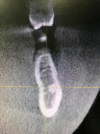Impacted Third Molars, A Rare Occurrence of Identical Bilateral Impacted Mandibular Third Molars in Linguo-Buccal Location: A Case Report
- PMID: 35004073
- PMCID: PMC8721465
- DOI: 10.7759/cureus.20858
Impacted Third Molars, A Rare Occurrence of Identical Bilateral Impacted Mandibular Third Molars in Linguo-Buccal Location: A Case Report
Abstract
Symmetrical horizontal impacted bilateral mandibular third molar in lingo-buccal direction is a rare type of impacted teeth. When a tooth cannot erupt and fails to achieve a normal function and occlusion during its chronological age of eruption, it is called an impacted tooth. In this paper, a case of a male patient aged 20 years old who had bilateral horizontally impacted lower third molar which was noticed in a routine screening panoramic radiograph and confirmed with cone beam computed tomography (CBCT) imaging and referred to the oral maxillofacial surgical center for surgical removal of the impacted teeth in order to avoid late complications is discussed.
Keywords: bilateral; impaction; lingo-buccal direction; surgical extraction; symmetrical.
Copyright © 2021, Kolarkodi et al.
Conflict of interest statement
The authors have declared that no competing interests exist.
Figures







Similar articles
-
External root resorption of the second molar associated with mesially and horizontally impacted mandibular third molar: evidence from cone beam computed tomography.Clin Oral Investig. 2017 May;21(4):1335-1342. doi: 10.1007/s00784-016-1888-y. Epub 2016 Jun 18. Clin Oral Investig. 2017. PMID: 27316639
-
Can preoperative imaging help to predict postoperative outcome after wisdom tooth removal? A randomized controlled trial using panoramic radiography versus cone-beam CT.Clin Oral Investig. 2014 Jan;18(1):335-42. doi: 10.1007/s00784-013-0971-x. Epub 2013 Mar 15. Clin Oral Investig. 2014. PMID: 23494455 Clinical Trial.
-
Pattern of occurrence and treatment of impacted teeth at the Muhimbili National Hospital, Dar es Salaam, Tanzania.BMC Oral Health. 2013 Aug 6;13:37. doi: 10.1186/1472-6831-13-37. BMC Oral Health. 2013. PMID: 23914842 Free PMC article.
-
[Dissertations 25 years after date 47. Third molars in the lower jaw].Ned Tijdschr Tandheelkd. 2016 Dec;123(12):591-597. doi: 10.5177/ntvt.2016.12.16116. Ned Tijdschr Tandheelkd. 2016. PMID: 27981263 Review. Dutch.
-
Impacted Mandibular Third Molars: Review of Literature and a Proposal of a Combined Clinical and Radiological Classification.Ann Med Health Sci Res. 2015 Jul-Aug;5(4):229-34. doi: 10.4103/2141-9248.160177. Ann Med Health Sci Res. 2015. PMID: 26229709 Free PMC article. Review.
References
-
- Impacted maxillary canines: a review. Bishara SE. Am J Orthod Dentofacial Orthop. 1992;101:159–171. - PubMed
-
- The impacted lower third molar and its relationship to tooth size and arch form. Ng F, Burns M, Kerr WJ. Eur J Orthod. 1986;8:254–258. - PubMed
-
- Panoramic radiographic predictors of mandibular third molar eruption. Niedzielska IA, Drugacz J, Kus N, Kreska J. Oral Surg Oral Med Oral Pathol Oral Radiol Endod. 2006;102:154–158. - PubMed
-
- Evaluation of the indication for surgical extraction of third molars according to the oral surgeon and the primary care dentist. Experience in the Master of Oral Surgery and Implantology at Barcelona University Dental School. Fuster Torres MA, Gargallo Albiol J, Berini Aytés L, Gay Escoda C. https://pubmed.ncbi.nlm.nih.gov/18667984/ Med Oral Patol Oral Cir Bucal. 2008;13:0–504. - PubMed
Publication types
LinkOut - more resources
Full Text Sources
